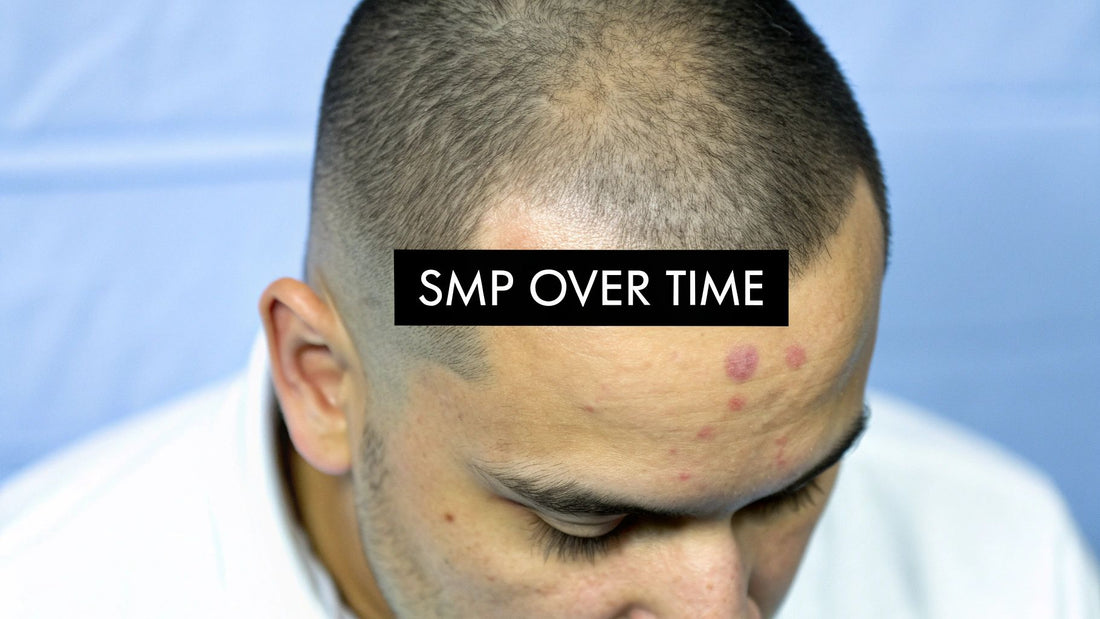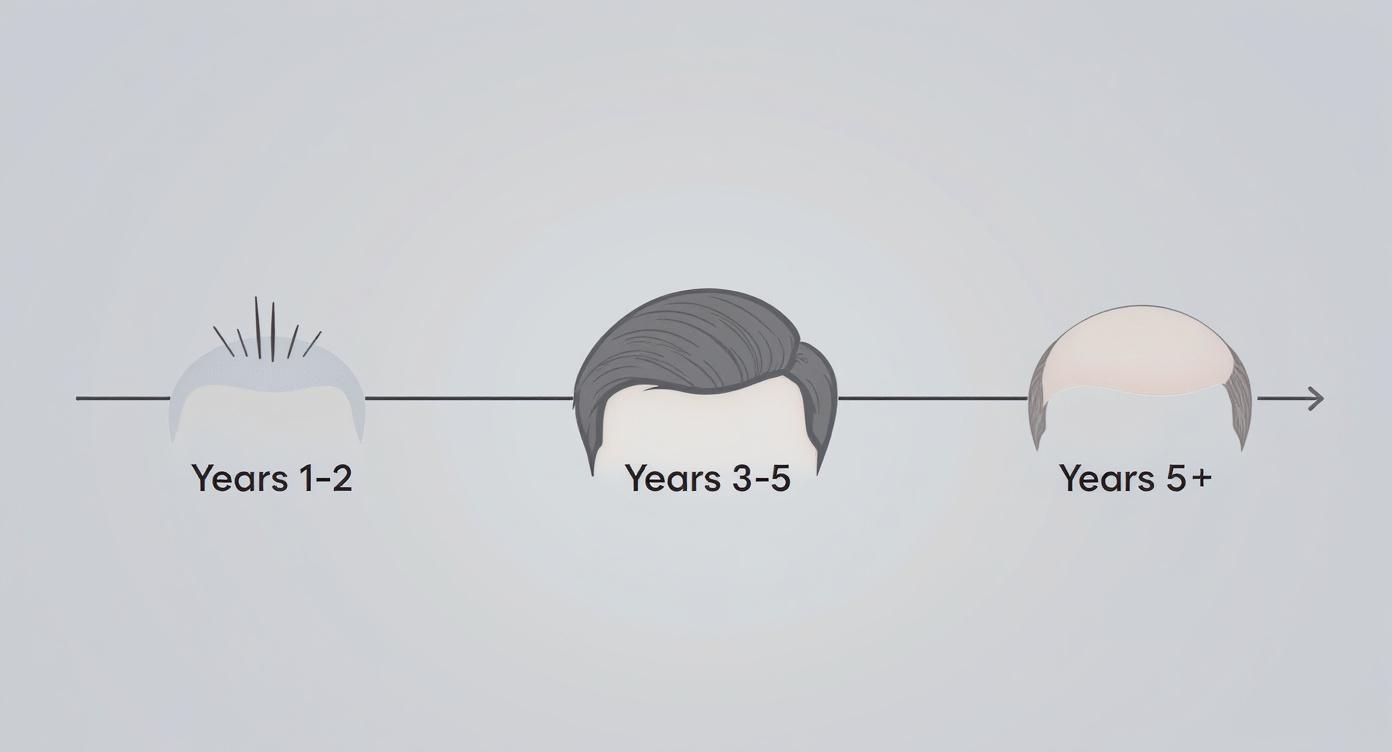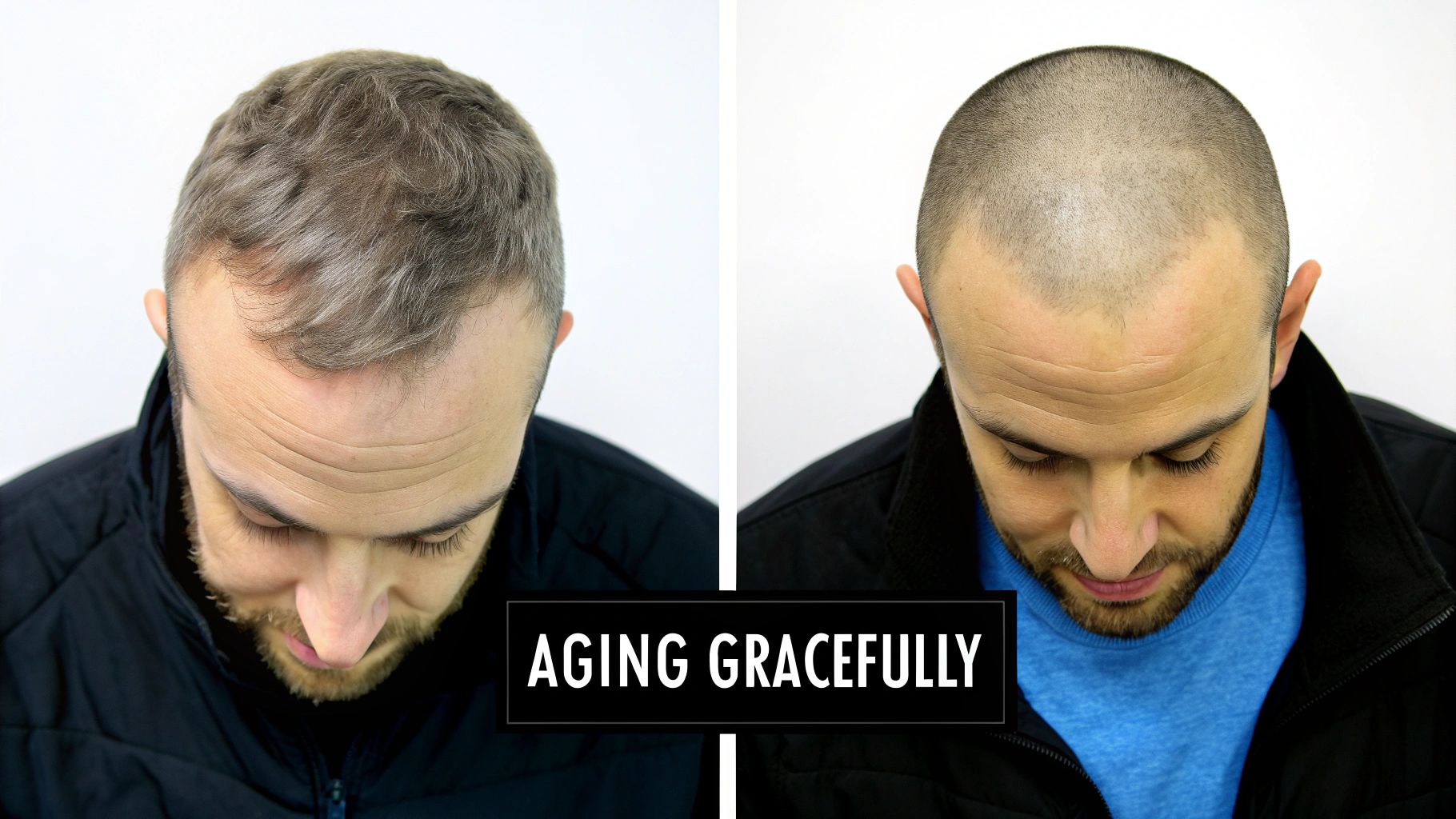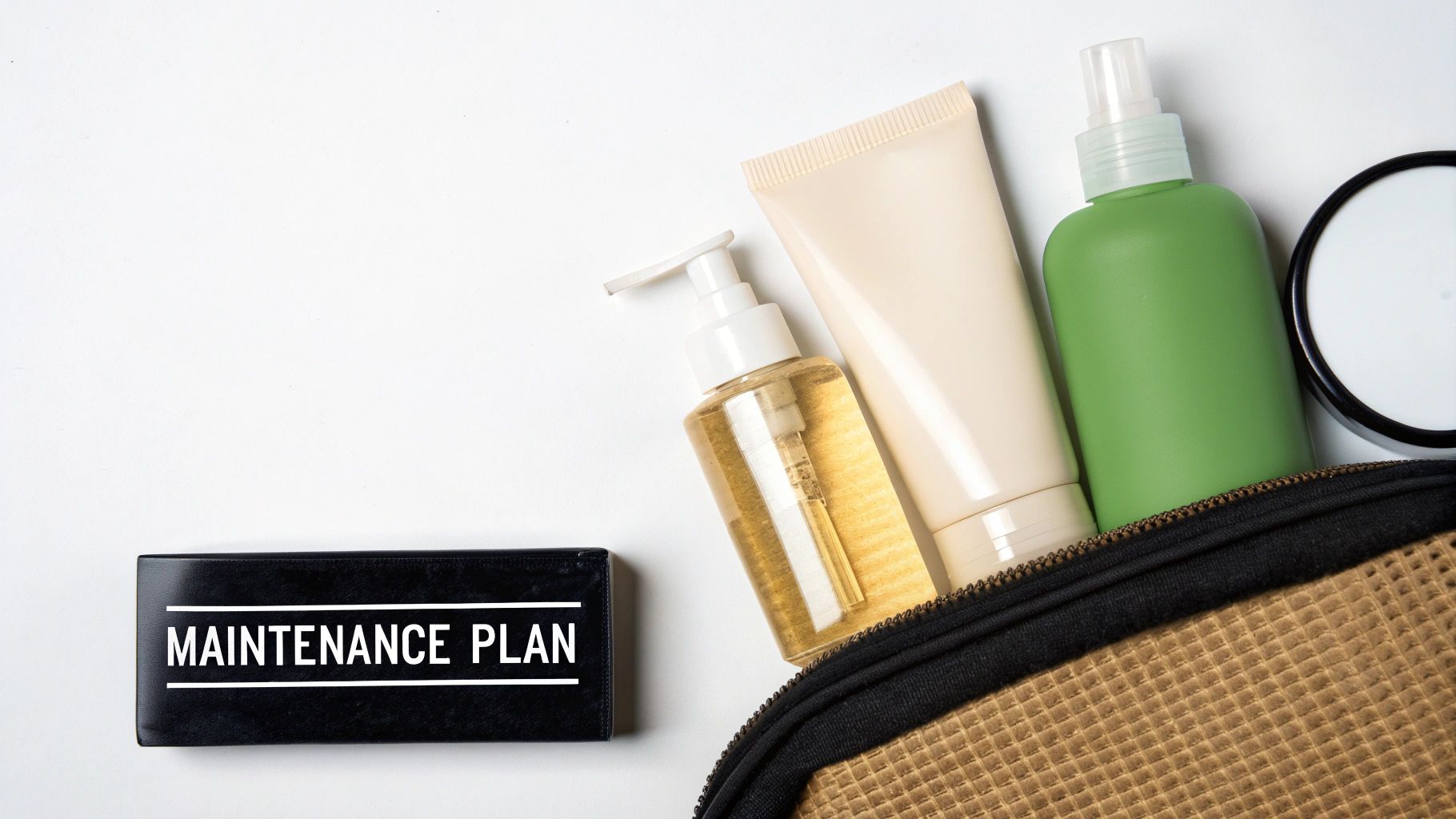
How Does My Hair Tattoo Look as I Get Older?
Share
One of the best things about a hair tattoo, or Scalp Micropigmentation, is that it’s designed to fade softly and naturally as the years go by. Unlike a traditional tattoo that can take on a bluish or greenish tinge, SMP pigments are made to simply lighten over time.
This controlled fading is actually a crucial feature. It gives you the flexibility to make adjustments down the track, ensuring your look always stays natural and suits you as you age.
Your Hair Tattoo's Journey Through Time
"How will my hair tattoo look as I get older?" It's one of the first and most important questions we hear. And it’s a smart one to ask. You need a solution that looks fantastic today, but also five, ten, or even twenty years from now.
The great news is that SMP is built for the long haul. Think of it less like permanent body art and more like a long-term cosmetic treatment that evolves right alongside you. It's not a ‘set and forget’ procedure; it's a dynamic solution that’s meant to be maintained.
The Typical SMP Timeline
Right after your final session, your SMP will look sharp, dark, and perfectly defined. This crisp, fresh appearance usually holds strong for the first couple of years.
As time passes, you’ll start to see a gradual softening of the pigment. This isn't a problem or a flaw in the treatment—it’s exactly what’s supposed to happen. This softening process is what keeps the result looking so convincingly real.
This timeline gives you a good idea of how SMP typically evolves, from that initial sharpness to a softer, more blended look over the years.

As you can see, the most noticeable change usually happens between years three and five. This is the sweet spot when most people start thinking about their first touch-up.
To give you a clearer picture, here’s a quick breakdown of what you can generally expect in the first few years.
Expected SMP Appearance Changes Over the First 5 Years
| Timeframe | Expected Appearance | Recommended Action |
|---|---|---|
| Years 1-2 | Pigment is still crisp, dark, and well-defined. Looks very fresh. | Enjoy the results! Focus on sun protection and proper aftercare. |
| Years 3-4 | The overall look begins to soften. Edges may look less sharp. | Start assessing the fading. You might consider booking a consultation. |
| Year 5 | Noticeable lightening. The colour has faded into a more subtle shade. | This is the prime time for a touch-up to restore density and definition. |
This table shows a typical progression, but remember, everyone's experience will be slightly different based on their skin and lifestyle.
When to Expect Your First Touch-Up
Most people find their hair tattoo looks great for 3 to 5 years before the fading becomes obvious enough to need a refresh. This isn't a hard and fast rule, though. Factors like your skin type, how your immune system responds, and especially your sun exposure habits can speed up or slow down the process.
A key advantage of this gradual fading is adaptability. As your own hair grays or your hairline naturally matures, a touch-up session is the perfect opportunity for your artist to adjust the pigment colour and density. This ensures your hair tattoo always complements your current age and style.
It’s also worth noting that many Australian clinics now use advanced techniques with finer needle impressions for an incredibly realistic look. Because this pigment is placed more shallowly in the skin, it can sometimes fade a little faster. But this semi-permanent nature is what makes SMP such a versatile and future-proof solution.
Why Hair Tattoos Age More Gracefully Than Body Tattoos

If you're considering a hair tattoo, you might be picturing how traditional body art ages—blurry lines, faded colours, and that classic, unappealing blue-green tint. It’s a valid concern, but thankfully, Scalp Micropigmentation (SMP) is a completely different ball game.
The reason SMP ages so well comes down to the craft itself: the specific pigment used, the precise depth of the application, and the ultimate goal of the treatment.
Think of it like this. A body tattoo uses ink that’s like bold oil paint, designed to be permanent and make a statement. SMP pigment, on the other hand, is more like a specialised watercolour, carefully formulated to create subtle, natural-looking layers that mimic tone and shadow.
The Science of the Pigment
The biggest difference lies in what the pigment is actually made of. Traditional tattoo inks are often complex mixtures of organic compounds, heavy metals, and various additives that produce bright, lasting colours. Over many years, your immune system works to break these foreign particles down, which can alter the ink’s chemical makeup and cause the colours to degrade and shift. That’s how a black tattoo can start to look blueish as the carbon particles break down unevenly.
SMP sidesteps this entire issue by using a highly specialised pigment. These are typically simple, carbon-based formulas, free of the complex colourants you'd find in body art ink.
This pure, carbon-based formula is incredibly stable. It’s engineered to be broken down by the body over time without changing its fundamental colour. As it fades, it just lightens to a softer, charcoal or grey version of the original shade—it will never turn blue or green.
This guarantees that as your hair tattoo ages, it continues to look natural and blends right in with your existing hair.
The Importance of Skin Depth
The other game-changer is how deep the pigment goes. A traditional tattoo artist pushes ink much deeper into the skin, right into the mid-dermis. This depth is what gives the tattoo its permanence, but it also makes the ink particles more prone to spreading or "migrating" over time, causing those fuzzy, blurred lines we've all seen.
In contrast, an SMP artist works in a much shallower layer of skin—the upper dermis.
This shallower placement is deliberate and gives us two huge advantages:
- Crisp Impressions: By placing the pigment just beneath the epidermis, the artist can create thousands of tiny, distinct dots. These impressions stay sharp and successfully replicate the look of individual hair follicles without blurring.
- Controlled Fading: Being closer to the surface means the pigment is more exposed to the body's natural renewal processes. This allows for a predictable and very gradual lightening over several years.
This slow, controlled fading isn’t a bug; it's a feature. It stops the hair tattoo from ever looking too harsh or dated. More importantly, it allows for adjustments down the track, ensuring the treatment can adapt as you age, your hair goes grey, or even if your style changes. A hair tattoo is designed to evolve with you, not against you.
Factors That Shape How Your SMP Ages
How your hair tattoo looks years down the track isn’t just about the clock ticking. It's a direct reflection of your own unique biology and the day-to-day choices you make. A good way to think about it is like a fine print on a canvas. The quality of that canvas—your skin—and how you shield it from the elements will ultimately decide how sharp and fresh that print stays.
You actually have a surprising amount of control over how long your treatment lasts. While you can't change your skin type or how your immune system works, just understanding them puts you in the driver's seat when it comes to long-term care.
Your Skin and Immune System
Your own body is one of the biggest players in how your SMP settles in and ages. Everyone's skin and immune response is a little different, which is why the timeline for fading is never exactly the same from one person to the next.
Let's break down the key internal factors:
- Skin Type: If you have oily skin, you might notice the pigment softening or fading a bit faster than someone with dry skin. This is simply because higher oil (sebum) production can interfere with how the pigment settles and gets broken down over time.
- Immune Response: Your immune system is hardwired to see foreign particles and clear them out. SMP pigment is no exception. A really active immune system might go to work on the pigment more quickly, while a less aggressive one will let it stick around for longer.
- Cell Turnover: The speed at which your skin naturally sheds and renews itself also has an impact. Faster cell turnover means the pigment can lighten more quickly. You can get a better sense of how this works by understanding the hair growth cycle.
These are things you can’t really control, of course. But knowing about them helps set a realistic timeline for when you might need your first touch-up.
External Lifestyle Choices
This is where you can make a genuine difference. Your daily habits have a direct impact on the pigment's integrity and are absolutely crucial for keeping your look sharp.
Sun exposure is, without a doubt, the number one enemy of SMP. UV rays act like a slow, steady laser, breaking down the pigment particles and causing them to fade prematurely. This is especially true in a high-UV climate like Australia.
Long-term maintenance is a huge piece of the puzzle. Here in Australia, SMP artists often see faster fading simply because of our harsh sun. A tell-tale sign that you’re due for a touch-up is when your real hair follicles start to look darker than the SMP dots. While SMP is incredibly low-maintenance, you’ve got to be realistic and plan for a bit of upkeep to keep it looking fresh.
Beyond just the sun, a few other lifestyle factors can speed up the fading process:
- Harsh Hair Products: Shampoos packed with sulphates or a lot of alcohol can dry out your scalp and accelerate pigment fade.
- Chlorinated Water: If you're a frequent swimmer, the chlorine in pools can have a gradual bleaching effect on the pigment.
- Excessive Sweating: Normal sweating is totally fine, but if you're consistently sweating heavily from intense workouts, it can contribute to the pigment fading a little quicker.
The principles of how pigment sits in the skin are shared with tattooing. To dive deeper into the artistry and fundamental techniques that influence how ink ages, you could explore a dedicated tattoo masterclass. By getting a handle on these external factors, you're actively protecting your investment and making sure your hair tattoo looks its absolute best for years to come.
Adapting Your Hair Tattoo to Your Evolving Look

One of the biggest questions we hear is, "Will my hair tattoo still look right in ten or twenty years?" It’s a fair point. As you get older, your appearance changes, and you want a hair loss solution that can change right along with you.
The answer is a definite yes. A high-quality SMP treatment isn’t meant to be a static, unchanging mark on your skin. Think of it more as a dynamic solution, designed to be refined and adjusted as you move through different stages of life.
Artful Adjustments During Touch-Ups
A touch-up session is much more than just darkening faded pigment. For a skilled practitioner, these appointments are a chance to artfully adapt the treatment to your current look, making sure it remains a seamless and undetectable part of your style.
These strategic updates are precisely what keeps your hair tattoo looking as natural at 60 as it did at 40.
Key adjustments include:
- Blending with Greys: As you naturally start to go grey, your artist can introduce lighter, grey-toned pigments during a touch-up. This creates a sophisticated "salt and pepper" look that blends perfectly with your greying hair.
- Softening the Hairline: A sharp, strong hairline might be the look you want in your thirties, but a slightly recessed and softer hairline often appears more distinguished as you age. This is an easy adjustment to make during a refresh.
- Adding New Density: If your natural hair loss continues, a touch-up can add more density to new areas of thinning, maintaining that full, even coverage.
Think of your SMP artist as a master tailor for your scalp. Just as you’d have a suit altered to fit you perfectly over the years, your hair tattoo can be adjusted to always complement your features.
A Growing Solution for Australian Men
It's no surprise that SMP's popularity is on the rise, especially here in Australia where male pattern baldness is so common. With around 50% of Australian men experiencing significant hair loss by age 50, many are looking for effective, non-surgical solutions.
The long-term adaptability of a hair tattoo is a huge part of its appeal, offering lasting confidence as men get older. You can learn more about Australian tattoo trends in this 2022 statistics update.
This flexibility means your treatment won't look dated or out of place. It also keeps your options open if you're considering other procedures. In fact, many people explore how SMP can be combined with a hair transplant for a comprehensive approach to hair restoration.
Your Long-Term SMP Maintenance Playbook
To keep your hair tattoo looking sharp for years to come, you'll need a solid game plan for maintenance. Think of it like looking after a classic car; a bit of consistent effort goes a very long way in preserving its appearance and value. The good news is that your first line of defence against fading comes down to simple daily habits.
These steps aren’t complicated or time-consuming, but they are absolutely crucial. By building them into your regular routine, you’re actively shielding the pigment from the elements and keeping your scalp in prime condition for a crisp, long-lasting result.
Your Daily and Weekly Checklist
The foundation of great long-term SMP care is built on two key pillars: sun protection and gentle cleansing. The intense Aussie sun is the number one culprit for degrading pigment, so treating your scalp with the same care you give your face is non-negotiable.
Here’s a straightforward routine you can follow:
- Daily Sun Protection: Every single morning, even on cloudy days, apply a high-SPF, non-greasy sunscreen to your scalp. I always recommend looking for SPF 50+ formulas that offer broad-spectrum protection against both UVA and UVB rays.
- Gentle Cleansing: Stick to using a mild, sulphate-free shampoo two to three times a week. Sulphates are harsh detergents that can strip away moisture and, over time, slowly cause the pigment to fade.
- Regular Moisturising: Keep your scalp hydrated with a light, non-comedogenic moisturiser each day. A healthy, moisturised scalp stops dryness and flaking, which can otherwise make the pigment look dull and less defined.
Proper aftercare is most critical in the first few weeks after your sessions, but these habits should really become lifelong. A well-maintained scalp doesn't just preserve your SMP; it also creates a healthier environment for any existing hair you have.
What to Avoid for Pigment Longevity
Just as important as what you do is what you don't do. Certain products and ingredients can actively work against your SMP, speeding up the fading process and compromising the natural look you invested in. Getting into the habit of checking labels is key.
You can find more in-depth advice in our guide detailing 5 top tips to care for your scalp after SMP.
Here’s a quick list of things to steer clear of:
- High-Alcohol Products: Lots of aftershaves, tonics, and hair products contain high concentrations of alcohol. This is incredibly drying for the skin and can make the pigment fade much faster than it should.
- Harsh Exfoliants: Avoid using any scrubs or chemical exfoliants that have ingredients like glycolic or salicylic acid directly on your treated scalp. These products are designed to increase skin cell turnover, which is the opposite of what you want for pigment longevity.
- Tanning Beds: The concentrated UV exposure from tanning beds is one of the most damaging things for SMP pigment. To protect your investment, they should be avoided entirely.
By following this playbook, you take control of how your hair tattoo ages, ensuring it remains a sharp and natural-looking solution for many years to come.
Common Questions About Ageing with a Hair Tattoo

Thinking about how your SMP will look years down the track is smart. It’s one of the most common things clients ask about, and getting straight answers is key to feeling confident about your decision. Let's dive into the most frequent questions we hear from people considering a hair tattoo for the long haul.
Will My Hair Tattoo Turn Blue or Green?
This is probably the biggest myth out there, and it’s an understandable one. We’ve all seen old body tattoos that have turned a strange shade of blue or green over time.
Thankfully, with modern SMP, that’s not something you need to worry about. The reason is simple: we don’t use traditional tattoo ink. SMP uses a specialised, carbon-based pigment designed specifically for the scalp. These pigments don't contain the unstable colourants that cause old tattoos to discolour.
Instead of turning blue, SMP pigment is designed to just gradually lighten over many years, fading into a softer, greyish tone of the original colour. As long as you choose an experienced artist who uses the right stuff, your look will stay natural.
What Happens If I Go Completely Grey?
This is another great question. Life happens, and hair colour changes. The good news is that your SMP is designed to evolve right along with you.
When you start to see more silver in your hair, a skilled practitioner can easily perform a touch-up. They’ll use lighter pigment shades and blend them seamlessly with your existing SMP, creating a really authentic "salt and pepper" look that matches your changing hair.
If you eventually go completely grey or white, the SMP that's already there simply acts as a subtle shadow on the scalp. This creates the illusion of density for a full head of closely shaved hair, so you maintain that sharp buzz-cut frame without any harsh, unnatural contrast.
It’s all about making sure the result looks right for you at any age.
How Often Will I Need Touch Ups Later in Life?
You’ll find that touch-ups become less frequent as you get older. The most noticeable fading typically occurs within the first 3-5 years after your initial sessions.
Once you’ve had that first major touch-up, you might only need another one every 5-7 years, or even longer. As we age, our body's metabolism and immune system—the very things that slowly break down the pigment—tend to slow down. This means the treatment naturally holds its appearance for longer in older clients.
Ultimately, it all comes down to personal preference. Some people are happy with a more faded, subtle look, while others prefer to keep it looking fresh.
Can I Remove My Hair Tattoo Later?
Absolutely. If you ever decide that SMP is no longer for you, it can be removed. The process involves laser treatment, and it’s generally much quicker and easier than removing a standard body tattoo.
This is because the carbon-based pigment is deposited in the upper layers of the skin, not as deep as traditional ink. It responds incredibly well to laser, often requiring only 2-4 sessions to either completely remove it or lighten it significantly.
It’s a great safety net to have, knowing there’s a permanent way out if your style or preferences change. You can get a more detailed look into the process and find out how scalp micropigmentation can be removed.
At My Transformation, we're dedicated to helping you achieve a hair loss solution you can feel confident about for years to come. Contact us today to book your consultation.
